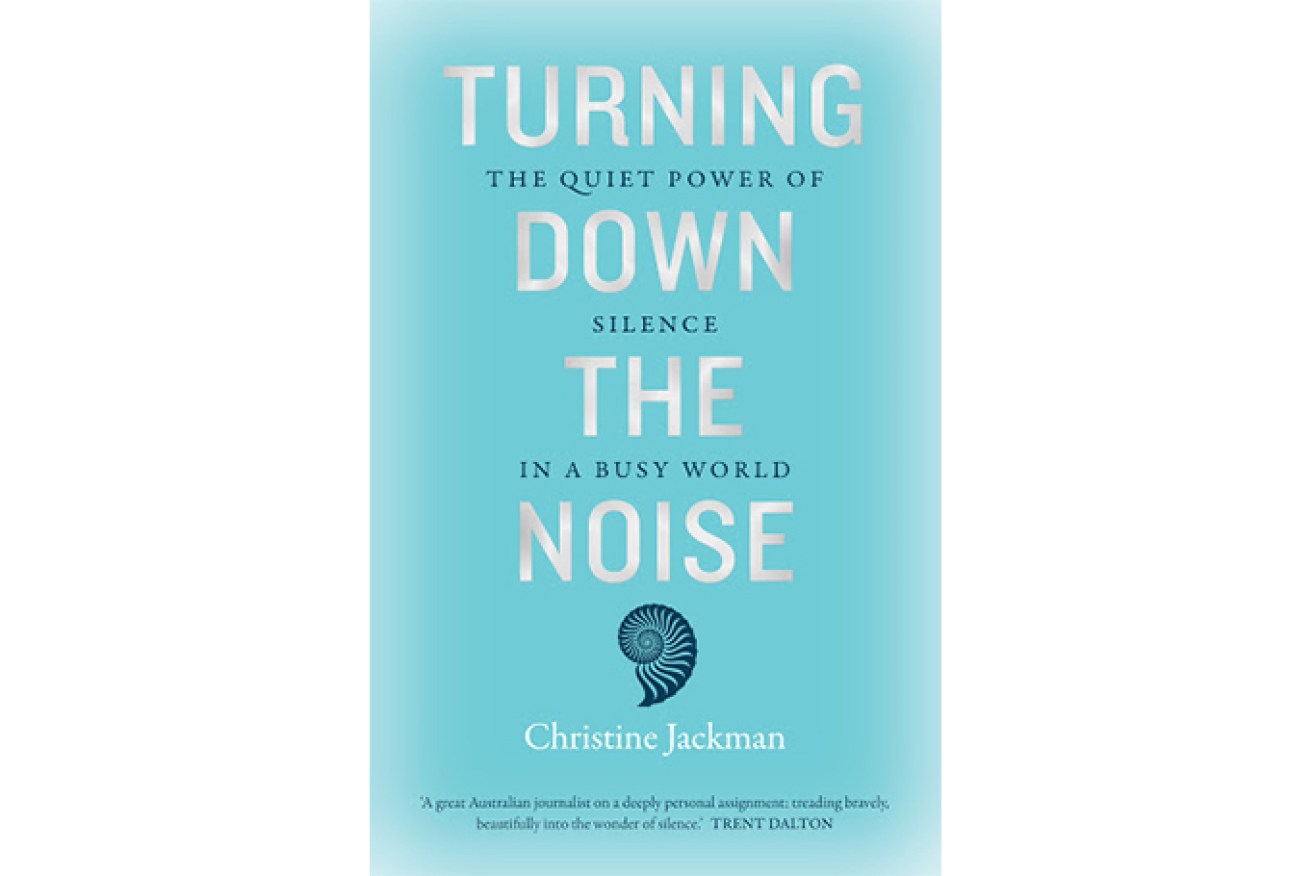Silence is golden: An extract from Christine Jackman’s Turning Down the Noise
In today’s Summer Reading book extract, Brisbane writer (and InQueensland columnist) Christine Jackman, in a quest to rediscover quiet and silence in a noise-filled world, went on two silent retreats. She gives an insight into why:

‘Edited extract from Turning Down the Noise by Christine Jackman. Murdoch Books RRP $32.99’.
‘Quiet please . . .’ The electronic message flashed up on the fence encircling the Gabba’s cricket field like a digital bracelet, a string of advertising gems glinting as they beckoned for our attention. The punchline followed: ‘Just joking!’
No kidding. There was no escaping the din as we joined more than 26,000 other cricket fans for a Big Bash League match between struggling locals the Brisbane Heat and the dominant Sydney Thunder in mid-January 2019, a few weeks after Peter and I got home.
Between deliveries, the stadium erupted with thumping pop music, coordinated clapping, stamping and chants. There were familiar audience participation activities too: members of the crowd were encouraged to kiss their partners, or hoist their youngest child in the air to the music of The Lion King, or demonstrate the latest dance craze—in our case the maddening ‘Baby Shark’. All for the roaming cameras. And all accompanied by more blaring beats.
Of course, social media was an integral part of the experience. There were free tickets to win, and even admission to the coveted ‘pool deck’—where body-confident fans could enjoy a premium viewing position from a swimming pool built on the boundary, provided they posted pictures with the requisite hashtags to Instagram and Twitter.
And in case anyone was still missing the point, frequent announcements ordered spectators to ‘make some noise!’, with an artificial meter on the electronic scoreboard purporting to measure the commotion.
I didn’t need the Gabba’s pretend device. By then I had become so obsessed with noise and sound that I had downloaded a portable decibel meter app, recommended by audiologists, onto my phone. When the crowd erupted, the meter often climbed to about 90 decibels, the threshold beyond which prolonged exposure (eight hours or more) is likely to cause permanent damage.
The needle swung even higher just once, when three small children sitting directly behind us combined to emit a piercing screech, a sound you might expect if the flying monkeys from The Wizard of Oz were fed through a giant blender.
In my teens and early twenties, I had often visited the Gabba to watch Test cricket, as well as the one-day international match that was routinely scheduled in Brisbane during the slow, heat-drenched weeks of early January. But those fond memories were from decades ago, back when the ground was fringed by quaint wooden stands and a cluster of Moreton Bay figs, as shaggy and drooping as many of the fans who tottered into the members’ stand.
The crowd back then was separated from the playing field by a broad, grassed track used for greyhound racing; it was rumoured that one of the best views of the play was from the roof of the toilet block at the neighbouring East Brisbane State School. With all its quirks, the old Gabba was as much a personality as the players who clashed there. It felt organic, alive: a white lotus spreading out and up to greet the bleaching Queensland sun.
The sleek stadium we sat in for the Big Bash game was better equipped for large crowds, with multiple entry and exit points, easily accessible toilets and, of course, a vast array of food and drink outlets. But it also felt like we had landed in a parallel universe; this wasn’t the Gabba I remembered. To butcher a popular Star Trek phrase: ‘It’s cricket, Jim, but not as we know it.’
The nonstop entertainment and crowd participation had clearly been borrowed from baseball, calling to mind raucous afternoons I’d spent drinking warm Budweiser at Yankee Stadium as a New York–based foreign correspondent. Either the entertainment had grown louder or I had grown older and less tolerant. Perhaps both.
Regardless, within minutes of us taking our seats, I developed a thumping headache and a fluttering nervous feeling in the back of my throat.
Still, the boys were having fun, especially when they were joined by their young cousins (including five-year-old Felix, a Brisbane Heat tragic, who had to be dissuaded by his dad from bringing a sign declaring ‘Sydney Are Idiots’). My younger son was busy posing for selfies and urging me to post the results on Twitter, while the other maintained the fine Australian tradition of grumpy armchair commentary, ranting about those on the field who were a joke, and others who were worthy of Australian selection but had been robbed of that status by the clearly biased selectors.
But after a couple of hours, all the on-field action stalled: two of the massive banks of lights that crouched over the stadium like glowering sci-fi gargoyles had fallen dark. For the spectators in the stands, the change in playing conditions was barely perceptible. But out by the wicket, the captains were conferring with the umpires about whether it was now too dim to safely face a hardened sphere of leather hurled at up to 150 kilometres per hour.
For once, the incessant chatter of social media provided no additional information; nobody seemed to know why the lights had failed or how long it would take to repair them. As the minutes dragged on, and even the most enthusiastic fans became restless with the music and other distractions, we decided to ‘up stumps’ (as they say in cricket) and head home early. The Heat were already looking like they would be soundly beaten; why prolong the agony?
When we got outside, though, we discovered that the buses scheduled to provide free transport for ticket holders after the game were not due for another hour or so. We could either wait by a busy intersection in the smothering humidity or trudge the couple of kilometres back to where we had parked our car.
We walked. As we did, the crackling energy generated inside the stadium quickly fizzled and soured. One son grumbled and fretted about his ears ringing, while the other, still twitching with the adrenaline of the game, insisted on reciting, in rapid-fire succession, a list of the most gruesome scenes in a horror movie he wanted us to see.
My head throbbed. My feet ached. And as the hyperstimulation of the past few hours ebbed away, it seemed to be leaching all the clarity and calm I had cultivated so attentively at the Vipassana retreat. I tried focusing on my breathing. I tried observing without judgement what was going on around me. I tried—oh, how I tried!—consciously maintaining equanimity.
We came to a point in the busy three-lane road where we would either have to risk crossing or take a lengthy detour in the other direction, under a bridge and down a few extra blocks before we would be able to double back to the parked car. It was getting late. We were all tired. And hot. And I was sure I could almost see the car from where we stood. Looking back up the road, I could see a break in traffic.
‘Run!’ I yelled.
‘Wait!’ Peter cried, almost simultaneously.
Seconds later, three of us were on one side of the road, and one cranky teenager was on the other, with another thick flood of cars in between. The familiar surge of nausea—that dreadful, primal feeling that accompanies any moment when you think your child is in danger—was already subsiding within me, leaving a curdled mix of bile and the pressing need to blame someone other than myself for this mess.
I yelled at Peter for distracting everyone. I yelled at the cranky son for not paying attention. I yelled at the other son for reasons I can’t recall, but possibly because he was yelling when I was yelling. I was not equanimous and I was certainly not silent.
After we finally managed to get everyone on the same side of the road, into the car and halfway home, I apologised to my family for losing my temper. Only then did I fall into silence, but not in any peaceful way. Embarrassed and annoyed with myself, I slid into a familiar pattern of self-recrimination. I was obviously a complete failure at meditation. I was a failure at equanimity. I was a failure at parenting.
I was a failure at life! How could I have become so easily overwhelmed so soon after leaving a Vipassana retreat?
But perhaps, I thought as I reflected further, there was another way of looking at it. Perhaps, had I not learned and practised those Vipassana techniques, I would not have lasted as long as I did, immersed in that hyper-stimulated environment, given my longstanding aversion to noise and crowds. In fact, it was possible I would not have even considered an outing to the Big Bash had I not felt so refreshed and recharged by the retreat.
Perhaps, too, the added awareness Vipassana had given me—the ability to watch my emotions arise and pass like a violent summer storm—had helped me recover more quickly from this setback, enabling me to make peace with my family rather than stewing or prolonging the recriminations. Everyone else in the car had moved on happily enough—they were busily discussing the highlights of the night and making plans for the following day.
Now I just had to make peace with myself.
Sitting a ten-day meditation retreat in silence was definitely one of the toughest things I have ever done. But after that night at the cricket, I realised this wasn’t ‘mission accomplished’. The retreat had been a beginning, not an end.
I was reminded of the handful of people I knew who had done detox retreats at health spas like Gwinganna. Returning to work afterwards, they would always insist it had been the hardest week of their lives: they’d given up caffeine, alcohol, meat and sugar, battling their cravings with shots of apple cider vinegar and the occasional raw health ball. Still, as they recounted their experiences of pre-dawn yoga and afternoon colonic irrigations, they would positively glow. Pure energy seemed to ooze from their freshly unclogged pores; joy would sparkle in their clearer, whiter eyes.
And then, six months later, I’d spy them in the office canteen ordering a double shot of coffee, or at a friend’s birthday party nursing another sav blanc, and they’d look just like everyone else. They’d roll their not-so-clear, not-so-white eyes and confess that they’d stopped getting up early for yoga and had abandoned apple cider vinegar after discovering it could cause tooth decay. They’d often look embarrassed, crestfallen at how the kilos had crept back on and dark shadows were once again stretching beneath their eyes.
I’d reassure them that it’s hard in the real world, when you wake up in the morning to be greeted not by a personal chef whipping up a delicious tofu scramble or a peppy yoga instructor ready to help you into pigeon pose, but by a sniffling child who has lost his tennis racquet, another who forgot he had an English assignment due today, with no bread left in the pantry for school lunches and a cat that has coughed up a hairball right where your foot just landed.
This time it was me who needed to be reminded: it’s hard in the real world. It was also a whole lot noisier.
We receive the lessons we are ready for, the ones we most need. I’m sure some guru somewhere said that. Or maybe I read it on an inspirational calendar or on Instagram. Regardless, it was certainly true of our night at the Gabba. The roiling atmosphere of the Big Bash had provided an excellent contrast to the tranquillity of Tasmania. And it was important to recognise that neither was typical of real life.
On most days, we don’t have to cope with the amplified, sensory jumble of a sold-out sports event. But nor can we expect the perfectly calibrated peace of a secluded meditation retreat. We have to find a balance. And to do that, it helps to identify first where all the noise is coming from—and, importantly, which are the most acute or damaging sources. Then we must find the most effective and restorative sources of silence in our lives, and work out how to access them regularly. Simple, right?
Fortunately, unlike the Desert Fathers and Eastern monks of centuries gone by, who had to rely on instinct, faith and shared personal experiences to guide them, we also have plenty of science.
According to the Australian Academy of Science, ‘noise can be identified as any unwanted or offensive sounds that unreasonably intrude into and disturb our daily lives’. The word itself derives from a Latin root meaning ‘queasiness’ or ‘nausea’. In other words, the sounds in your life don’t become ‘noise’ until they irritate you or make you sick.
The problem is, one man’s highly enjoyable sporting event can be another woman’s splitting headache, as I had discovered. Similarly, you can be exposed to identical decibel levels at a sell-out rock concert as you will encounter standing on an aircraft runway as a jumbo jet takes off, but you’re only likely to whip out your credit card to pay for one of those experiences.
What we identify as ‘noise’ is highly subjective. That’s important, because our personal definitions of noise will, in turn, influence what we then identify and seek as ‘silence’. There is no absolute silence, as in a complete absence of sound, in the living world within earth’s atmosphere. There are only states where the irritating stimuli we think of as noise are reduced dramatically. Both noise and silence, then, are rhetorical shapeshifters, bending and flexing depending on the context and one’s personal proclivities.
History demonstrates as much too. The first noise ordinance is believed to have been passed in the sixth century BC, when the good folk of the Greek colony of Sybaris took such umbrage at the clamour made by tinsmiths, potters and other tradespeople that the council eventually banned them from living in the city. They were forced to move beyond the city’s walls, along with all roosters, after the poor birds were also found guilty of disturbing the peace. In 44 BC, Julius Caesar was so irritated by the traffic noise of ancient Rome that he intervened, restricting when wagons would be allowed on the city’s streets. And in 1595, Rule 30 of London’s ‘Lawes of the Market’ targeted men making ‘any such suddaine outcry . . . in the still of night’, explicitly banning them from singing, or ‘beating hys Wife, or servant’ after 9 p.m.
But when the Industrial Revolution swept across Europe and then America in the late 1700s and early 1800s, all of those previous noise complaints suddenly seemed trivial. Roosters, wagons and busy tradespeople were no match for the thundering roar of factories and steam engines. (Shamefully, it would take almost another two centuries for domestic violence to be recognised as more than just a disturbance to the peace in many Western nations.)
Scientists were beginning to take an interest in how soundwaves worked, and particularly in the impact of industrial noise. In 1886, Scottish surgeon Thomas Barr issued the first warning about noise exposure in the workplace, after documenting the considerable damage done to the hearing of a group of 100 boilermakers. However, for the most part it was left to concerned citizens and community organisations to protest what they considered to be the most bothersome sources of noise. Two of the most clamorous cities on the planet at that time — London and New York — were host to some of the most concerted campaigns, with luminaries such as Charles Dickens supporting efforts in London and Mark Twain joining the New York movement.
Things changed dramatically in the twentieth century, and not just because of the arrival of cars and planes, as well as an array of tweeting, trilling personal devices and appliances, all of which contributed to growing noise levels wherever humans were found. The invention of the decibel as a unit of measurement in the 1920s, along with the development of portable recording equipment throughout the century, made it much easier for scientists to draw links between certain types and levels of noise and physiological impacts on the human body.
By 2011, the World Health Organization had reviewed the amassed body of research to estimate the impact of environmental noise on Europeans, expressed as disability-adjusted life years (DALYs): that is, the number of years lost due to disability, ill health or premature death. Its report, Burden of Disease from Environmental Noise, quite deliberately sought to focus on the harm caused by exposure to incidental noise, such as road traffic, passing aircraft and trains, construction and neighbourhood activity, separate from workers’ exposure to industrial noise. The issue of occupational hearing loss, one of the most common workplace illnesses, was not considered, in part because this problem could be addressed separately, through industrial laws and regulation.
Reviewing data from a variety of large-scale epidemiological studies, the WHO’s working group of experts declared that ‘there is overwhelming evidence that exposure to environmental noise has adverse effects on the health of the population’. Specifically, they found exposure to excessive environmental noise contributes to ischemic heart disease, tinnitus, sleep disturbances and cognitive impairment (learning difficulties) in children. Many other studies suggesting possible links between noise pollution and an array of other conditions, including ulcers, colitis and other gastrointestinal upsets, headaches and hypertension, were ruled out as inconclusive or lacking statistical rigour.
Using noise-mapping techniques and data, the authors were able to estimate the number of Europeans living in areas where potentially dangerous levels of noise were routinely recorded. From there, they used a complex array of formulae to calculate how many of those people were likely to develop serious health problems, based on the reviewed research. A lack of comparable noise maps from eastern European cities forced them to limit those projections to the west of the continent. Even so, their conclusions were stark: ‘[T]he total burden of health effects from environmental noise would be greater than one million years in western Europe, even with the most conservative assumptions that avoid any possible duplication.’ Three years later, the EU’s first noise assessment report offered a similarly dire prognosis, concluding that noise pollution was responsible for 43,000 hospital admissions in Europe annually, and at least 10,000 premature deaths.
Oddly, Australia lags behind in this research area. To be fair, this may be partly due to the luxury of space still enjoyed by most Australians, with relatively few people dwelling in the cramped and close urban environments of many of their counterparts in London, Paris or New York. Indeed, it’s worth noting that Australians enjoy an odd #firstworldproblem. In most comparable countries, the most common source of noise complaints is traffic. In Australia, according to at least one review of local council records, it is barking dogs.
Of course, that cannot be expected to last forever.
Assigned to conduct a review of the problem in 2014, a panel of health, environmental and acoustics experts acknowledged that they were hamstrung by ‘a lack of systematic data for the Australian context [which] makes understanding and quantifying our noise environment difficult’. Without noise maps and other data that had been available to the European researchers, the Australians were unable to model accurately the impact of noise pollution on local cities and towns. They were also more cautious than the Europeans about accepting as conclusive some of the more alarming research findings, calling for further work in a number of areas.
However, the Australian report did concur that ‘there is sufficient evidence of a causal relationship between environmental noise and both sleep disturbance and cardiovascular disease to warrant health-based limits for residential land uses’. Specifically, it recommended that environmental noise around Australian homes be limited to no more than 55 decibels for eight hours at night, and 60 decibels for a sixteen-hour daytime period. In other words, if the noise in and around your home is louder than a normal conversation for prolonged periods during the day, or above the sound of moderate rainfall at night, your health is at risk.
Relatively new techniques such as functional magnetic resonance imaging (fMRI), electroencephalography (EEG) and electrocardiography (ECG), for example, have revolutionised the study of sleep, allowing scientists to observe and document what is actually going on in the brain, rather than relying on their subjects to self-report on the quality or otherwise of their sleep. And so far, the discoveries in this field have shone new light on how insidious noise can be.
The bad news, particularly for those who believe they can snooze through anything, is that noise can erode the quality of sleep at a deep physiological level, even if the subject believes they have not been disturbed. In one 2012 study, for example, Harvard sleep researcher Orfeu Buxton played ten-second clips of different types of sounds — such as doors closing, phones ringing, city traffic and machinery — to healthy volunteers as they slept. With each noise, he noted, various parts of the body roused—measured by spikes in heart rate and neural activity—even when the subjects did not awaken.
Buxton’s observations make sense from an evolutionary perspective. There’s a good reason why our ears don’t have ‘lids’ like our eyes do. For most of human history, people have not slept securely behind locked doors in alarmed premises on civilised, well-policed streets (much of the world’s population still don’t have that luxury). At night, while their other senses rested in slumber, our ancestors relied on hearing—the sole sentinel left in the watchtower—to alert them to possible danger.
We remain hardwired to tune in to noise at night, to discern whether it is a threat and prepare to respond to it. Even if we don’t remember it, noise can trigger a stress response in the amygdala, the brain’s centre for emotion and memory. The amygdala sends a distress signal to the control centre of the brain, the hypothalamus, which then issues a call-out to the rest of the body to prepare for fight or flight.
Only relatively recently in our evolution have our bodies been subjected to so many man-made noises, in such a sustained way, at night and during the day. So it is hardly surprising that our brains are yet to catch up. As a result, many of us exist in a sustained state of ‘fight or flight’ or hyper-arousal, with associated physiological changes such as increased pulse and quickened breathing, which were only ever intended for emergencies. You don’t need a medical degree to intuit that this can be exhausting. At night, however, when the body needs sleep to engage in a range of vital restorative functions, such a state can be downright debilitating, if not ultimately life-threatening.
‘I find our current environment and atmosphere highly toxic,’ Buxton told Scientific American’s Dorian Rolston in 2013. ‘We are constantly being pattered by sounds, many of them alerting-alarms or attention-getting in an obnoxious way that activate your response to stressors . . . I greatly appreciate silence and natural noises.’
But while researchers like Buxton may have enjoyed silence as a welcome oasis from toxic levels of noise, it had generally been ignored as a subject for specific research. In the lab, if it was recognised at all, it was merely as a useful control, a blank slate on which more interest- ing variables could be imposed and scrutinised. When silence finally captured the attention of the scientific community, it was entirely by accident.
In 2006, Italian physician Luciano Bernardi set out to test whether music had the potential to help manage stress, by playing six different tracks to a group of 24 subjects and measuring their physiological changes. He found that almost all the tracks triggered cardiovascular and respiratory shifts that indicated focused attention. But then he noticed even more dramatic changes—in the pauses between the tracks. While the musical pieces had relaxed his subjects to differing degrees, it was the intervening periods of silence that had the greatest impact on them physiologically. Bernardi surmised that the silences, contrasted with the musical pieces, were somehow triggering a ‘release’ in the brain that led to an even greater state of relaxation.10
Music as a stimulus also featured in research by biologist Imke Kirste. In 2013, Kirste was researching what types of stimuli might trigger neurogenesis, or the growth of new brain cells, in adult mice. Neurogenesis is arguably one of the most exciting fields of neuroscience, given that until the end of the twentieth century it had been widely accepted that the brain ceases to create cells beyond the initial stages of human development. Hypothesising that the calls of baby mice (pups) might activate new cell growth in adults, Kirste decided to test those sounds in comparison to an array of other auditory conditions, including white noise, silence and the ‘baseline ambient noise’ of her lab at Duke University.
Looking for additional stimuli that would be unfamiliar to the pups, Kirste added two Mozart sonatas to the experiment. Later, she acknowledged that choosing Mozart was partly a ‘tongue-in-cheek’ dig at an infamous set of studies done a few years earlier, which had credited the music with improving cognitive performance in human listeners. An international craze for ‘Baby Mozart’ CDs had followed, with thousands of unwitting infants (including one of mine) subjected to Mozart on high rotation, before the studies were widely discredited.
Initially, Kirste observed that all the stimuli, apart from white noise, prompted some neurological changes in the mice, noting with some surprise that both silence and Mozart had a greater effect than the natural calls of mice pups. But the real shock came a week later. At that point, only the mice exposed to silence showed sustained signs of new cell development, specifically in the hippocampus, which is the brain’s centre for learning and memory. Kirste surmised that silence, far from representing an absence of anything interesting, ‘might be the most arousing [stimulus], as it is highly atypical’. Indeed, the mice were so stimulated by silence that they had begun generating new brain cells, in preparation for ‘future cognitive challenges’.
The findings of scientists like Bernardi and Kirste throw down an incontrovertible challenge to the assumption that silence is benignly peaceful at best, and oppressively boring at worst. At a neural level, at least, silence is an event in itself, and one which may trigger changes and growth we are only beginning to understand. Meanwhile, as a natural prophylactic to the established negative side effects of excessive noise—heart disease, high blood pressure, insomnia and learning difficulties—surely it makes sense for us to seek out and protect the quiet places in our modern world.
‘Edited extract from Turning Down the Noise, by Christine Jackman. Murdoch Books, RRP $32.99’.












